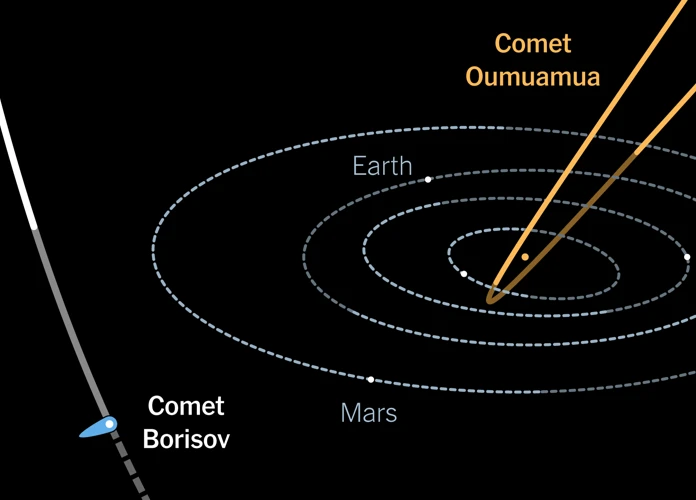Tracking the Path of Comets in our Solar System is a fascinating endeavor that sparks wonder and curiosity in both scientists and space enthusiasts alike. Comets, mysterious celestial objects composed of ice and rock, traverse the vastness of space in elliptical orbits, occasionally making appearances in our night skies. Understanding the formation, composition, and trajectories of comets provides valuable insights into the history and dynamics of our Solar System. In this article, we will explore the intriguing world of comets, delve into the methods used to track their paths, and uncover the significant discoveries made through studying these enigmatic wanderers of the cosmos. So, fasten your seatbelts and prepare to embark on a cosmic journey through space and time.
Contents
- Overview of Comets
- Formation of Comets
- Comet Orbits
- Studying Comet Trajectories
- Tools for Tracking Comets
- Comet Predictions and Orbital Evolution
- Impacts and Hazards
- Conclusion
-
Frequently Asked Questions
- What causes comets to have tails?
- How big are comet nuclei?
- Can comets collide with planets?
- How do scientists determine the composition of comets?
- Have any comets ever been visited by spacecraft?
- What are the potential hazards associated with comets?
- How are comets named?
- Can comets be a source of water for space exploration?
- Do all comets have tails?
- Can comets change their orbits?
- References
-
Frequently Asked Questions
- 1. How do comets form?
- 2. Where do comets come from?
- 3. What is the composition of comets?
- 4. What are the different types of comets?
- 5. How are comets observed from Earth?
- 6. What spacecraft missions have studied comets?
- 7. What can we learn from studying comet trajectories?
- 8. What tools are used to track comets?
- 9. How do scientists predict the future path of comets?
- 10. Are comets a potential hazard to Earth?
- References
- Read More
Overview of Comets
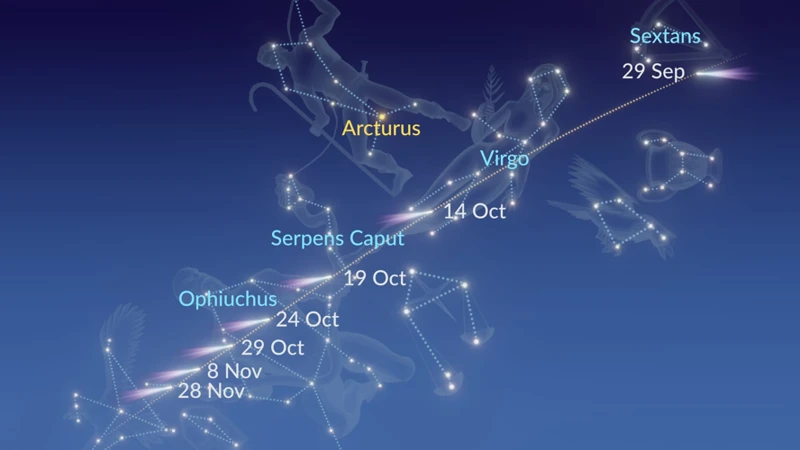
Comets, celestial wonders that grace our night skies, are captivating objects that have captivated the human imagination for centuries. Comets are composed of a mixture of ice, dust, rock, and organic compounds, forming a frozen nucleus often referred to as the “dirty snowball”. These icy bodies originate from the outer regions of the Solar System, in a region known as the Oort Cloud. Comets can be classified into two types based on their orbital paths: short-period comets with orbits that take less than 200 years to complete, and long-period comets with orbits that can take thousands or even millions of years. Short-period comets are believed to originate from the Kuiper Belt, a region beyond the orbit of Neptune. The graceful and erratic motions of comets have long fascinated astronomers, and their study has contributed to our understanding of the origin of the Solar System and the dynamic processes that shape its celestial inhabitants.
What are comets?
- A comet is a celestial object that consists mainly of a nucleus, coma, dust tail, and ion tail. The nucleus is the solid core of the comet, typically composed of ice, rock, and organic compounds. As a comet approaches the Sun, the heat causes the ice in the nucleus to vaporize, creating a glowing coma, which is the cloud of gas and dust that surrounds the nucleus.
- The coma is illuminated by the Sun, giving it a fuzzy appearance. In addition to the coma, comets also have two types of tails. The dust tail is composed of tiny particles of dust that are swept away from the coma by the pressure of sunlight. It often appears yellowish-white and curves away from the Sun due to the solar wind. The ion tail, on the other hand, is composed of ionized gas molecules that are influenced by the Sun’s magnetic field. It typically appears bluish in color and points directly away from the Sun because of the solar wind.
- Comets are believed to be remnants from the early stages of our Solar System’s formation, carrying with them valuable information about the composition and conditions present during that time. They are sometimes referred to as “dirty snowballs” due to their icy composition.
- Comets can vary in size, with nucleus diameters ranging from a few kilometers to several tens of kilometers. The larger comets are typically more active, producing more gas and dust as they approach the Sun.
Formation of Comets
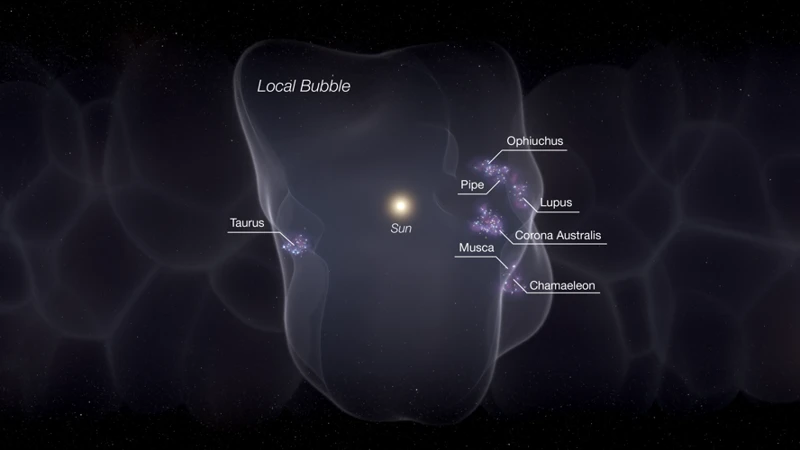
The formation of comets is a captivating process that takes place in the outer regions of our Solar System. Comets are believed to have formed from the leftover material that was present during the early stages of the Solar System’s formation. As the nebula of gas and dust collapsed, a protoplanetary disk formed, from which planets, moons, and other celestial bodies emerged. Within this disk, small icy and rocky particles known as planetesimals began to clump together through a process called accretion. Over time, these planetesimals grew larger and eventually formed the nuclei of comets. These nuclei, often no larger than a few kilometers in diameter, are composed of a mixture of volatile ices, such as water, carbon dioxide, methane, and ammonia, along with dust and rocky materials. The precise details of how comets form and the specific mechanisms involved are still the subject of ongoing research and investigation, but studying their formation provides valuable insights into the early history and dynamics of our Solar System. So grab your metaphorical space suit and let’s embark on a journey to explore the intricate origins of these icy wanderers.
How do comets form?
Comets form through a complex process that begins with the accumulation of icy particles and dust in the outer reaches of the Solar System. These regions, such as the Oort Cloud and the Kuiper Belt, are composed of remnants from the early stages of the Solar System’s formation. As gravity draws these particles together, they gradually coalesce to form larger objects known as planetesimals, which can range in size from a few kilometers to several hundred kilometers in diameter. Over time, these planetesimals continue to collide and grow, eventually developing into fully-fledged comets with distinct nuclei, coma, and tails. The nuclei of comets, often referred to as the “dirty snowballs,” consist of a mixture of water ice, frozen gases such as carbon dioxide and methane, and various rocky materials. When a comet approaches the Sun, heat causes the icy nucleus to vaporize, creating a glowing coma that surrounds the nucleus. The solar wind and radiation pressure then push away some of the coma’s material, forming the iconic tail that points away from the Sun. This remarkable transformation as comets journey towards the inner regions of the Solar System showcases the dynamic nature of these celestial objects and provides valuable insights into the formation and evolution of our cosmic neighborhood. To learn more about the fascinating connections between mythology and astronomical phenomena, check out our article on the unveiling of the Terracotta Army in Chinese mythology.
Where do comets come from?
Comets originate from the outer regions of our Solar System, particularly from a vast and distant region called the Oort Cloud. The Oort Cloud is believed to be a spherical shell of icy bodies surrounding the Sun at a distance of about 2,000 to 100,000 astronomical units (AU). Comets in the Oort Cloud are remnants from the early formation of the Solar System, containing volatile compounds such as water, frozen gases, dust, and rocky material. These objects are thought to have been formed closer to the Sun and were then scattered outward due to gravitational interactions with the giant planets, such as Jupiter and Saturn. Occasionally, disturbances caused by the gravitational pull of nearby stars or the gravitational effects of passing objects can disturb the delicate equilibrium of the Oort Cloud, causing some comets to be ejected from its grasp and sent hurtling towards the inner regions of the Solar System. Once in the inner Solar System, the heat from the Sun causes the volatile substances within the comet’s nucleus to vaporize and form a glowing coma and a spectacular tail that we observe from Earth. The journey from the Oort Cloud to the inner regions of our Solar System can take thousands or even millions of years, depending on the trajectory of each individual comet. This process of comets originating from the Oort Cloud and entering the inner regions of the Solar System is an ongoing cycle, contributing to the continuous presence of these celestial objects and captivating our interest in their elusive and awe-inspiring nature.
Comet nuclei
Comet nuclei, the solid cores of comets, are enigmatic objects that hold valuable clues about the early formation of our Solar System. They are typically small in size, ranging from a few kilometers to tens of kilometers in diameter. Within the comet nucleus, a variety of materials can be found, including volatile compounds such as water, carbon dioxide, methane, and ammonia, as well as rocky and metallic components. The nuclei are composed of a mixture of icy materials and rocky particles that are loosely bound together, giving them a porous and fragile structure. This porous nature is believed to be a result of a process called sublimation, where the sun’s heat causes the icy components to vaporize, leaving behind voids and cavities within the nucleus.
It is important to note that the composition of comet nuclei can vary depending on their origin and the conditions of their formation. For example, short-period comets, originating from the Kuiper Belt, are thought to have a higher proportion of volatile ices compared to long-period comets from the Oort Cloud. The examination of the nucleus of a comet provides valuable insights into the composition and physical properties of these intriguing objects. By studying the isotopic abundances of different elements and molecules within the nucleus, scientists can gain a deeper understanding of the processes that occurred during the early stages of the Solar System’s formation. The study of comet nuclei has also revealed the presence of organic molecules, providing tantalizing evidence for the potential role of comets in the delivery of the building blocks of life to Earth.
In summary, comet nuclei are the solid cores of comets that contain a mixture of volatile ices, rocky particles, and organic compounds. Their composition and structure provide valuable insights into the early stages of our Solar System and the potential for delivering essential components for the emergence of life. Studying these enigmatic objects continues to unravel the mysteries of our celestial neighborhood.
Comet Orbits
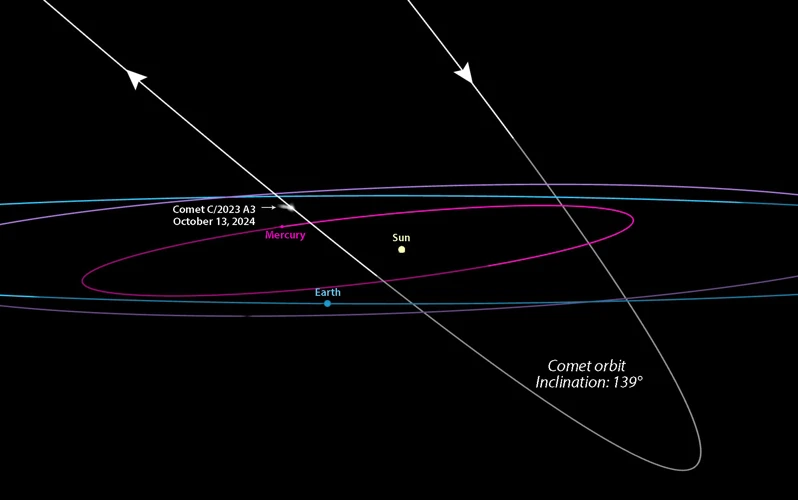
Comet orbits are characterized by their elliptical nature, which sets them apart from the more circular orbits of planets. These elongated paths result from the gravitational influence of the Sun and other celestial bodies in the Solar System. At their closest point to the Sun, known as the perihelion, comets experience intense heating and begin to emit gas and dust, forming a glowing coma and often a majestic tail. Conversely, at their farthest point from the Sun, known as the aphelion, comets reside in the outer reaches of the Solar System, maintaining their icy composition. The study of comet orbits has revealed the existence of comet families, clusters of comets that originate from the same parent body. These families provide valuable insights into the dynamics and evolution of comets, shedding light on their celestial origins and interactions with other objects in the Solar System. Understanding the complex and mesmerizing paths of comets is crucial for unraveling the mysteries of our cosmic neighborhood and discovering new celestial wonders.
Elliptical nature of comet orbits
The elliptical nature of comet orbits is a defining characteristic that sets them apart from other celestial bodies in our Solar System. Comets follow elongated paths around the Sun, shaped like flattened ovals known as ellipses. These ellipses have two distinctive points called the perihelion and the aphelion. The perihelion is the point in the comet’s orbit where it is closest to the Sun, while the aphelion is the farthest point. The eccentricity of a comet’s orbit determines the shape of the ellipse, with higher eccentricities resulting in more elongated orbits. This elliptical nature explains why comets can spend the majority of their time in the outer reaches of the Solar System, only to swing by the Sun in a magnificent display of cosmic beauty. Due to their elliptical orbits, comets can vary greatly in their distance from the Sun, with some coming close enough to experience intense heating and outgassing, forming the characteristic coma and tails that make them visible from Earth. The study of these unique orbits provides valuable insights into the dynamics of the Solar System and the processes that shape the trajectories of these icy wanderers.
Perihelion and aphelion points
The Perihelion and aphelion points play a crucial role in understanding the orbital characteristics of comets. The perihelion is the point in a comet’s orbit where it is closest to the Sun, while the aphelion is the point where it is farthest away. These points determine the shape and duration of a comet’s orbit. When a comet reaches its perihelion, it is subjected to intense heat and radiation from the Sun, causing the volatile substances within the nucleus to vaporize and create a glowing coma and tail that we observe from Earth. The intense gravitational pull from the Sun at perihelion accelerates the comet’s speed, and as it moves away towards its aphelion, its motion gradually slows down. This change in velocity near the perihelion and aphelion points affects the shape of a comet’s orbit, which is typically highly eccentric or elongated. For example, astrologers believe that the perihelion points of comets can influence human behavior and events on Earth. Understanding the perihelion and aphelion points is crucial for predicting the behavior and trajectory of comets as they journey through our Solar System.
Comet families
Comet families are groups of comets that share similar characteristics and origins, providing valuable insights into the formation and evolution of these celestial objects. One example of a comet family is the Jupiter-family comets, which have orbital periods of less than 20 years and are gravitationally influenced by Jupiter. These comets are believed to originate from the Kuiper Belt and are captured into shorter, more elliptical orbits by the gravitational pull of Jupiter. Another notable comet family is the Oort Cloud comets, which have long orbital periods and originate from the distant Oort Cloud. These comets are believed to be remnants from the early formation of the Solar System and their trajectories can be influenced by passing stars or gravitational interactions with other objects. Studying comet families allows astronomers to trace their origins, understand the mechanisms that shape their orbits, and gain insights into the dynamics of the Solar System. By analyzing the composition and behavior of different comet families, scientists can uncover clues about the processes that occurred during the early stages of our cosmic neighborhood.
Studying Comet Trajectories
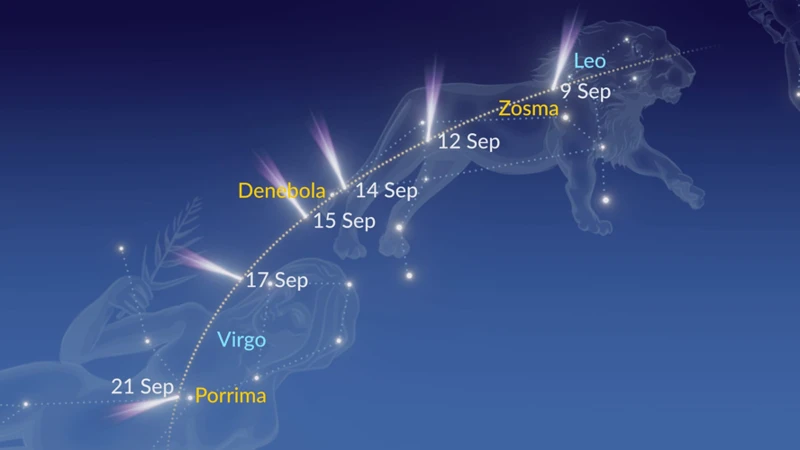
Studying comet trajectories is a complex and fascinating field of research that combines observations from both Earth and spacecraft missions. From Earth, astronomers have been observing comets for centuries, tracking their movements across the night sky and recording their positions over time. This has allowed for the identification of patterns and the determination of their orbital paths. Spacecraft missions, such as the New Horizons mission to Pluto, have provided up-close observations of comets, including detailed images and data on their composition, structure, and behavior. Through these combined efforts, scientists have made remarkable discoveries about comets, including their role as cosmic time capsules, containing valuable information about the early Solar System. By tracking and studying comet trajectories, we gain insights into the dynamics of our Solar System and the origins of these enigmatic objects, furthering our understanding of the universe.
Observing comets from Earth
Observing comets from Earth provides a unique opportunity to study these celestial objects up close and gather valuable data about their characteristics and behavior. One of the primary methods of observing comets is through optical telescopes, both professional observatories and amateur setups. These telescopes allow astronomers to track the movement of comets across the night sky, capturing detailed images and spectra. By analyzing the light emitted or reflected by comets, scientists can determine their composition, identifying elements and molecules present in the comet’s atmosphere and tail. Spectroscopy is particularly useful in studying the gas and dust ejected by comets as they approach the Sun.
In addition to optical telescopes, radio telescopes also play a crucial role in observing comets from Earth. Radio waves emitted by comets can provide valuable insights into their physical properties, such as their size, shape, and rotational characteristics. By analyzing the radio emissions, astronomers can also determine the presence of certain molecules in the coma and tail of the comet.
To enhance observations, astronomers make use of specialized instruments and techniques. One such technique is polarimetry, which measures the polarization of light from comets. Polarimetry helps determine the structure and composition of the dust particles in the comet’s coma.
The observations of comets from Earth are not limited to merely capturing images and spectra. Researchers also use techniques like astrometry to precisely measure the position and motion of comets. This data is crucial for calculating comet orbits and predicting their future paths.
The advent of digital imaging and advanced data analysis techniques has revolutionized the field of comet observation. Amateur astronomers, equipped with high-resolution cameras and image processing software, contribute significantly to monitoring and studying comets. The ability to share observations and collaborate through online platforms has led to a vibrant community of comet enthusiasts worldwide.
Observing comets from Earth allows scientists to gather data and refine our understanding of these captivating objects. Through optical and radio telescopes, spectroscopy, polarimetry, and astrometry, researchers can uncover the secrets of comets and unravel their mysteries, contributing to our knowledge of the Solar System’s formation and evolution.
Spacecraft missions to study comets
Spacecraft missions have played a crucial role in advancing our understanding of comets by allowing us to study these celestial wanderers up close. Here are some notable spacecraft missions that have been specifically designed to study comets:
- Stardust: Launched by NASA in 1999, the Stardust mission successfully collected samples from the coma (the cloud of gas and dust surrounding the nucleus) of comet Wild 2. The spacecraft returned to Earth in 2006, providing scientists with valuable insights into the composition and structure of comets.
- Deep Impact: As the name suggests, the Deep Impact mission, launched by NASA in 2005, involved deliberately crashing a projectile into the nucleus of comet Tempel 1. This collision allowed scientists to study the interior of the comet and analyze the composition of its subsurface layers.
- Rosetta: One of the most ambitious comet missions to date, the Rosetta mission, led by the European Space Agency (ESA), involved sending a spacecraft to rendezvous with comet 67P/Churyumov-Gerasimenko in 2014. The mission included the deployment of a lander called Philae, which successfully touched down on the surface of the comet. Rosetta and its instruments provided unprecedented data, shedding light on the composition, structure, and activity of a comet.
- Hayabusa: This mission, launched by the Japan Aerospace Exploration Agency (JAXA), aimed to collect samples from the near-Earth asteroid Itokawa. However, during its journey, Hayabusa also encountered a comet named 73P/Schwassmann-Wachmann. Although the mission faced numerous technical challenges, it managed to return a small sample of asteroid material to Earth in 2010, providing valuable insights into the relationship between comets and asteroids.
- Comet Interceptor: Currently in planning by the ESA, the Comet Interceptor mission aims to fly alongside a pristine, dynamically new comet in our Solar System. It will be comprised of three spacecraft, each with unique instruments to study the comet’s nucleus, coma, and surrounding dust environment. The unique aspect of this mission is its ability to react quickly and intercept a newly discovered comet, enabling scientists to study a fresh and unperturbed comet for the first time.
These space missions have significantly expanded our knowledge of comets, providing valuable data on their composition, structure, activity, and the processes that shape them. They have allowed us to witness firsthand the dynamic nature of comets and have unlocked profound insights into the mysteries of these captivating celestial objects.
Discoveries from studying comet trajectories
Studying the trajectories of comets has led to a multitude of profound discoveries and insights into the nature of these celestial objects. Here are some of the remarkable findings that have emerged from the meticulous examination of comet paths:
1. Identification of Comet Origins: By tracing the trajectories of comets, scientists have been able to determine their origins and categorize them into different families. This knowledge has helped unravel the mysteries surrounding the formation and evolution of comets.
2. Probing the Early Solar System: Comets are believed to be remnants from the early stages of the Solar System’s formation. By studying their trajectories, scientists have gained valuable information about the chemical composition and conditions of the early Solar System, shedding light on the conditions that led to the birth of our own planet.
3. Mapping the Oort Cloud: The study of comet trajectories has provided valuable insights into the structure and extent of the Oort Cloud, a vast region located at the outer edges of the Solar System. This has deepened our understanding of the dynamics and distribution of comets in this distant realm.
4. Cometary Contributions to Earth: Tracking comet paths has revealed that comets can potentially impact Earth, carrying the potential for both destruction and the delivery of valuable resources such as water and organic compounds. This information is crucial for understanding the risks associated with cometary impacts and for future space exploration.
5. Investigating Solar System Evolution: Comet trajectories help scientists investigate the long-term evolution of the Solar System. By studying their paths over millennia, scientists can make predictions about future encounters and assess the dynamics of the Solar System as a whole.
6. Unveiling the Origins of Life: Comets may have played a significant role in the origins of life on Earth. The study of comet trajectories has revealed that these icy wanderers contain complex organic molecules, including amino acids, the building blocks of life. This suggests that comets may have delivered the necessary ingredients for life on our planet.
By diligently analyzing the intricate paths of comets, scientists continue to make groundbreaking discoveries that deepen our knowledge of the Solar System’s history, formation, and potential impact on Earth. These findings not only captivate our imagination but also provide invaluable clues to unraveling the mysteries of our cosmic origins.
Tools for Tracking Comets
![]()
Tracking the paths of comets requires a range of specialized tools and techniques. Astronomers rely on a combination of telescopes and observatories to observe comets from Earth. These instruments, equipped with advanced optics and detectors, allow scientists to observe the comets’ brightness, size, and the structures within their tails. Additionally, space missions have been launched to study comets up close. These spacecraft missions provide invaluable data on the composition and behavior of comets. For instance, the Rosetta mission successfully placed a lander on the nucleus of Comet 67P/Churyumov-Gerasimenko, providing unprecedented insights into the composition and characteristics of comets. To analyze the vast amount of data obtained from comet observations, astronomers employ sophisticated software and algorithms to process and interpret the information. Data analysis techniques, such as image processing and spectral analysis, help scientists uncover valuable information about the composition, structure, and dynamics of comets. With the aid of these powerful tools, scientists continue to deepen our understanding of comets, unraveling the mysteries of these mesmerizing celestial bodies.
Telescopes and observatories
The study and tracking of comets heavily rely on the use of telescopes and observatories equipped with advanced astronomical technologies. These tools enable scientists to observe and monitor the trajectories of comets as they journey through space. Telescopes with large apertures and high-resolution imaging capabilities are particularly useful in capturing detailed images of comets, allowing scientists to analyze their structure, composition, and activity. Some observatories are specifically dedicated to tracking comets, such as the International Scientific Optical Network (ISON) and the Comet Observation Database (COBS). These observatories utilize powerful telescopes situated in different locations around the globe to ensure continuous observation and data gathering. Additionally, ground-based telescopes are often used in conjunction with space-based observatories like the Hubble Space Telescope to obtain a comprehensive view of comets. The data collected from these telescopes and observatories are analyzed using various techniques, including spectroscopy, which helps determine the chemical composition of comets and study their physical properties. The continuous advancements in telescope technology and observational techniques allow scientists to unravel the mysteries of comets and gain insights into their origins and behavior.
Software and algorithms
When it comes to tracking the path of comets, the use of advanced software and algorithms plays a crucial role. Astronomers and researchers rely on sophisticated technological tools to accurately predict and trace the trajectories of these celestial wanderers. Various software applications are employed to analyze observational data, calculate orbit elements, and simulate the movements of comets over time. These programs utilize complex algorithms that take into account gravitational forces from other celestial bodies, such as planets and moons, to precisely model the paths of comets. By inputting observational data, including position and velocity measurements, into these software systems, scientists can derive valuable insights into the dynamics and behavior of comets. These tools aid in predicting future positions of comets, identifying potential hazards, and determining the orbital evolution of these cosmic travelers. The development and refinement of software and algorithms continue to enhance our understanding of comets and their journeys through the vast expanse of our Solar System.
Data analysis techniques
Data analysis techniques play a crucial role in tracking the path of comets and extracting valuable insights from the vast amount of data collected. Astronomers employ a variety of sophisticated methods to analyze the information obtained from observations and spacecraft missions. One key technique is photometry, which involves measuring the brightness of a comet over time. This data helps scientists determine the size of the dust and gas released from the comet as it interacts with the Sun’s radiation. Another powerful technique is spectroscopy, which involves breaking down the light emitted or reflected by a comet into its constituent wavelengths. By analyzing the spectral fingerprints, scientists can determine the composition of the comet, including the presence of molecules such as water, carbon monoxide, and methane. Additionally, image processing techniques are used to enhance the quality of images captured by telescopes and spacecraft, enabling astronomers to study the structure and morphology of cometary nuclei, jets, and dust tails in greater detail. Furthermore, statistical analysis methods are employed to analyze large datasets, identify patterns, and make predictions about the behavior and future path of comets. These data analysis techniques, combined with advanced computational tools, assist scientists in unraveling the mysteries of comets and deepening our understanding of the dynamics of our Solar System.
Comet Predictions and Orbital Evolution
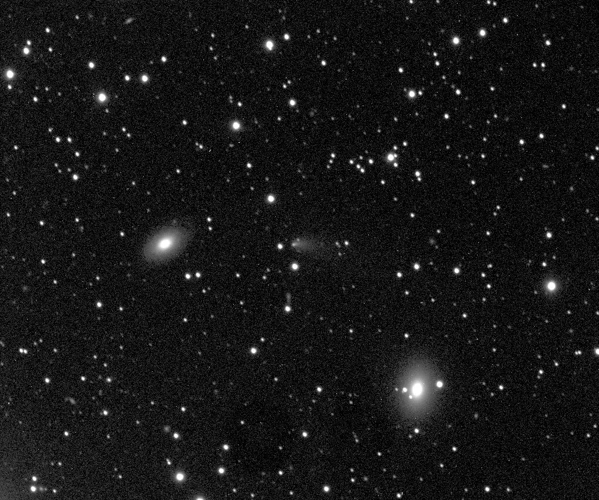
Predicting the future path of comets and understanding their orbital evolution is a complex task that requires careful observation and analysis. Scientists use a combination of observational data, mathematical models, and computer simulations to make predictions about the trajectories of comets. Factors such as the gravitational influence of planets, known as perturbations, can alter a comet’s path over time. Additionally, the sublimation of volatile materials as a comet approaches the Sun can cause outgassing, leading to changes in its trajectory. It is important to note that while scientists can make reasonably accurate predictions for short-term orbits, long-term orbital evolution can be more challenging to forecast due to the complexities of gravitational interactions and unpredictable factors. Nevertheless, studying comet predictions and orbital evolution provides valuable insights into the dynamic nature of our Solar System and enhances our ability to track and understand these mesmerizing celestial objects.
Predicting the future path of comets
One of the intriguing aspects of comets is the ability to predict their future paths as they journey through the Solar System. Predicting the future path of comets involves a meticulous analysis of their orbital parameters and the gravitational forces acting upon them. This process requires the use of sophisticated tools and techniques, including advanced software algorithms and data analysis methods.
Here are some key methods and considerations used in predicting the future path of comets:
1. Orbital calculations: Scientists employ complex mathematical calculations to determine the trajectory of comets based on known data such as their initial position, velocity, and gravitational influences from nearby celestial bodies. These calculations take into account the gravitational pull of the Sun, planets, and other significant objects in the Solar System.
2. Observational data: Continuous observations of comets using ground-based telescopes and space-based observatories provide valuable data for tracking their movements accurately. By measuring the position and brightness of comets at different points in their journey, astronomers can refine their predictions of future paths.
3. Gravitational perturbations: The gravitational pull from other celestial objects can significantly influence the trajectory of comets. Scientists carefully analyze the gravitational interactions between comets and nearby planets, moons, and asteroids to accurately forecast their future paths.
4. Computational simulations: Complex computer simulations are conducted to model the dynamics of comets and their interactions with the various gravitational forces in the Solar System. By running these simulations based on known physical laws and data, scientists are able to project the future path of comets over long periods of time.
5. Past observations: By studying the historical paths of comets and comparing them with present data, scientists can make predictions about future paths. This analysis involves examining orbital characteristics, including the period, eccentricity, and inclination of past comets to estimate how similar future comets may behave.
Predicting the future path of comets is a continuous and evolving process that benefits from advancements in technology and the accumulation of observational data. These predictions not only enable scientists to anticipate comet apparitions and study their behavior but also provide valuable insights into the dynamics and evolution of our Solar System.
Factors affecting comet trajectories
Factors affecting comet trajectories can be influenced by various celestial and environmental factors. These factors play a crucial role in determining the path and behavior of comets as they journey through the solar system. Here are some key factors that impact comet trajectories:
1. Gravitational Forces: The gravitational influence of massive celestial bodies, such as planets and the Sun, can significantly affect the trajectory of comets. As a comet passes near a planet, its path may be altered due to the gravitational pull, causing deviations from its original course.
2. Solar Radiation: Solar radiation, particularly from the Sun, can have a notable impact on a comet’s trajectory. The intense heat and radiation from the Sun can cause the volatile substances within the comet’s nucleus to vaporize, creating a glowing coma and tails. As the vaporized material is ejected, it exerts a gentle but continuous force known as solar radiation pressure, affecting the comet’s motion.
3. Outgassing: Cometary nuclei contain volatile substances like water, carbon dioxide, and other gases. When a comet gets closer to the Sun, the heat causes these volatile substances to sublimate, releasing gas and dust particles. This outgassing can generate jets of material that propel the comet and influence its trajectory.
4. Interactions with the Interstellar Medium: During its journey through space, a comet may encounter interstellar dust grains and gases. These encounters can lead to drag forces acting upon the comet, altering its trajectory and causing it to deviate from its expected path.
5. Collisions with Small Celestial Bodies: The presence of small asteroids or other debris in the path of a comet can cause gravitational interactions or physical collisions. Such interactions can disrupt the trajectory of the comet, altering its course as it encounters these objects.
Understanding these factors is essential for accurately predicting the paths of comets and gaining insights into their behavior. Scientists employ sophisticated models and simulations to study how these elements shape and alter comet trajectories, contributing to our understanding of the dynamics of comets as they journey through the vastness of space.
Long-term orbital evolution
The long-term orbital evolution of comets is a complex and intriguing phenomenon that plays a crucial role in shaping the paths these celestial objects take throughout their lifetimes. As comets journey through space, their orbits can be influenced by a variety of factors, including gravitational interactions with other planets, the Sun, and even passing stars. These gravitational perturbations can cause significant changes in a comet’s trajectory, altering its orbital period, eccentricity, and inclination over time. In some cases, comets may experience close encounters with massive objects that can result in orbital changes, such as Jupiter’s gravitational influence causing a comet to be ejected from the Solar System or sent on a path that eventually leads to a collision with a planet. The study of long-term orbital evolution provides valuable insights into the dynamics of the Solar System and helps astronomers predict the future paths of comets. By understanding how a comet’s orbit can change over vast timescales, scientists can better assess the potential risks of cometary impacts on Earth and gain a deeper understanding of the origins and evolution of comets in our cosmic neighborhood.
Impacts and Hazards
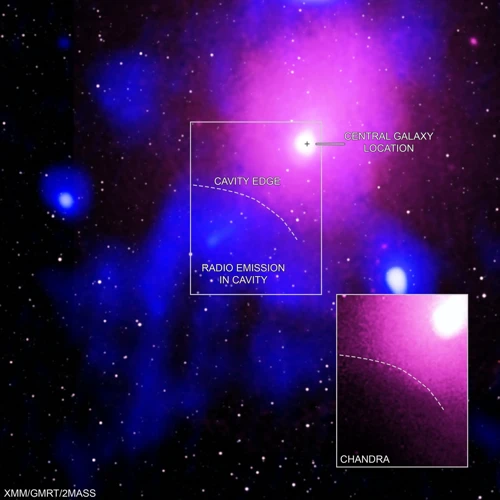
Comets, although mesmerizing, can also pose potential hazards to our planet. These celestial wanderers have occasionally collided with Earth throughout history, leading to catastrophic events. The Tunguska event of 1908 serves as a stark reminder of the destructive power of comets. A comet or asteroid, estimated to be around 60 meters in diameter, exploded in the atmosphere over Siberia, releasing an immense amount of energy and flattening an estimated 2,000 square kilometers of forest. Such impacts can cause widespread devastation, altering ecosystems and threatening human populations. However, comets also have a positive side to their impact. They are believed to be significant sources of water in our Solar System, which is crucial for the origin and sustenance of life. The presence of water on comets has raised the possibility of utilizing these cosmic icebergs as potential resources for future space exploration missions. So while comets can be hazardous, they also hold immense scientific and exploratory value, making them objects of both caution and fascination.
Comets and potential Earth impacts
Comets and potential Earth impacts have been a subject of great interest and concern among scientists and the general public. These icy visitors from the depths of space can pose a threat to our planet if their trajectories bring them too close to Earth. While the chances of a direct impact are relatively low, the consequences can be catastrophic. The famous impact of Comet Shoemaker-Levy 9 with Jupiter in 1994 serves as a stark reminder of the destructive potential of comets. Scientists have identified several past impact events on Earth attributed to comets, such as the Tunguska event in 1908, where a comet or asteroid exploded in the atmosphere with an energy equivalent to several nuclear bombs. Fortunately, most comets burn up in the Earth’s atmosphere, creating beautiful meteor showers rather than impacting the surface. Nevertheless, the study of comets and their trajectories plays a crucial role in the ongoing efforts to monitor and mitigate the potential dangers associated with these celestial wanderers. Through tracking their paths and understanding the key factors influencing their trajectories, scientists can better assess the risk of future impacts and develop strategies to protect our planet from potential catastrophic events. It is a reminder that even in the vastness of space, the delicate dance of comets can have profound effects on our home planet.
Comets as sources of water
Comets serve as fascinating sources of water in our Solar System, containing valuable clues about the origins of water on Earth and other celestial bodies. The composition of comets typically includes a significant amount of water ice, along with other volatile compounds such as carbon monoxide and carbon dioxide. When a comet approaches the Sun, the heat causes the ice to sublimate, transforming directly from a solid to a gas. This process creates a glowing coma, or atmosphere, around the comet, and gives rise to the characteristic long tail that extends away from the Sun. The water vapor released by comets can also form a gas cloud known as the coma, which envelops the nucleus. Additionally, as a comet’s trajectory brings it closer to the Sun, solar radiation and solar wind can interact with the coma, pushing the water molecules away and creating a tail that points in the opposite direction of the Sun. Some comets even have two tails, one composed of dust particles and another consisting of ionized gas. The study of comets as sources of water has provided valuable insights into the abundance and distribution of water in our Solar System, shedding light on the potential origins of water on Earth and its significance in the development of life.
The Tunguska event
The Tunguska event, one of the most mysterious and significant events in modern history, occurred on June 30, 1908, in a remote region of Siberia, Russia. This strange and powerful phenomenon is believed to have been caused by the explosion of a massive comet or asteroid in Earth’s atmosphere. The blast, estimated to be equivalent to several megatons of TNT, flattened around 800 square miles of forest, uprooting trees and causing seismic waves that were detected as far away as the United Kingdom. The exact cause and nature of the object that caused the Tunguska event remain a subject of scientific debate and speculation. Various theories have been proposed, ranging from a comet nucleus explosion to the impact of a small black hole or even a UFO crash. Despite numerous expeditions and studies conducted over the years, no conclusive evidence has been found to definitively identify the origin of the Tunguska event. However, the Tunguska event serves as a poignant reminder of the potential destructive power of astronomical objects and the need for continued monitoring and research to better understand and mitigate potential hazards that they may pose to our planet. To this day, the Tunguska event continues to intrigue scientists and captures the imagination of those curious about the mysteries that lie within our universe.
Conclusion

As we conclude our exploration of tracking the path of comets in our Solar System, we are left with a sense of awe and wonder at the mysteries that lie beyond our world. Throughout this article, we have delved into the formation, composition, and trajectories of comets, discovering the incredible diversity and beauty of these celestial objects. By studying comet trajectories, both from Earth and through spacecraft missions, we have gained invaluable insights into the dynamic nature of our Solar System. Tools such as telescopes, observatories, software, and data analysis techniques have aided in tracking and understanding the paths of comets. Additionally, predictions of comet paths and the factors that influence their trajectories have allowed scientists to forecast their future movements. The role of comets as potential hazards and as sources of water in our Solar System has also been explored. From the devastating Tunguska event to the potential for comets to impact Earth, studying comets is crucial for understanding the risks and opportunities they present. As we look to the skies and ponder the vastness of the cosmos, the study of comets continues to ignite our curiosity and inspire us to unlock the secrets of our universe. May our journey into the world of comets serve as a reminder of the infinite wonders that await our exploration.
Frequently Asked Questions

What causes comets to have tails?
Comets develop tails when they approach the Sun and heat causes the icy nucleus to vaporize. Solar radiation pushes the gas and dust away from the nucleus, creating a glowing coma and a tail that can stretch millions of kilometers behind the comet.
How big are comet nuclei?
Comet nuclei are relatively small, with sizes ranging from a few kilometers to tens of kilometers in diameter. The nucleus is the solid core of the comet and is composed of a mixture of ice, rock, and dust.
Can comets collide with planets?
While rare, comets can potentially collide with planets. Comets that enter the inner regions of the Solar System have their trajectories influenced by the gravitational pull of planets, increasing the chances of a collision. However, the likelihood of a direct impact with a planet like Earth is extremely low.
How do scientists determine the composition of comets?
Scientists study the composition of comets by observing the spectra of light reflected off the coma and tail. By analyzing this light, they can identify the chemicals present, such as water vapor, carbon dioxide, methane, and more, providing insights into the composition of comets.
Have any comets ever been visited by spacecraft?
Yes, several comets have been visited by spacecraft. For example, the European Space Agency’s Rosetta mission successfully landed a probe on comet 67P/Churyumov-Gerasimenko in 2014, providing invaluable data and images of its surface.
What are the potential hazards associated with comets?
The primary hazard associated with comets is the potential for them to collide with Earth. Although the likelihood of such an event occurring in the near future is low, it remains a possibility and has led scientists to study cometary trajectories extensively.
How are comets named?
Comets are typically named after the person or group of people who discovered them. However, there are some exceptions where comets are named after significant events or dedicated to individuals who have made exceptional contributions to the field of astronomy.
Can comets be a source of water for space exploration?
Yes, comets are believed to be a significant source of water in the Solar System. The icy composition of comets contains water in the form of ice, and this water can potentially be extracted and utilized for future space missions.
Do all comets have tails?
Not all comets have tails. The development of a tail depends on factors such as the proximity to the Sun and the composition of the comet. Only when a comet comes close enough to the Sun does the heat cause the release of gases and the formation of a visible coma and tail.
Can comets change their orbits?
Yes, comets can experience changes in their orbits. Factors such as gravitational interactions with planets and other celestial bodies can alter the trajectory of comets over time. These changes in orbit can be significant and can influence the frequency of a comet’s returns to the inner Solar System.
References
Frequently Asked Questions

1. How do comets form?
Comets are believed to form in the outer regions of the Solar System, where the temperature drops low enough for gases, water, and dust particles to freeze and come together to form a solid nucleus.
2. Where do comets come from?
Comets are thought to originate from two main regions: the Kuiper Belt and the Oort Cloud. The Kuiper Belt is located beyond Neptune, while the Oort Cloud is located much farther out, on the edges of the Solar System.
3. What is the composition of comets?
Comets are composed of a mixture of ice, dust, rock, and organic compounds. The ice mainly consists of water, ammonia, methane, and carbon dioxide. The dust is made up of tiny particles of minerals and silicates.
4. What are the different types of comets?
There are three main types of comets: short-period comets, long-period comets, and Halley-type comets. Short-period comets have orbits that take them around the Sun in less than 200 years, long-period comets have orbits of more than 200 years, and Halley-type comets follow a path similar to that of Halley’s Comet.
5. How are comets observed from Earth?
Comets can be observed from Earth using telescopes and observatories. Astronomers track their movements across the night sky and record their brightness and position to study their trajectories and behavior.
6. What spacecraft missions have studied comets?
Several spacecraft missions, such as the European Space Agency’s Rosetta mission and NASA’s Deep Impact mission, have been launched to study comets up close. These missions have provided valuable data about the composition and structure of comets.
7. What can we learn from studying comet trajectories?
Studying comet trajectories helps us understand the origin and evolution of comets, as well as the dynamics of the Solar System. It provides insights into the composition of comets and their interaction with the Sun and other celestial bodies.
8. What tools are used to track comets?
Telescopes and observatories equipped with advanced imaging technology are used to track and monitor comets. Software and algorithms help in predicting their paths and analyzing the collected data. Data analysis techniques aid in interpreting the information gathered.
9. How do scientists predict the future path of comets?
Scientists use mathematical models and simulations based on the laws of physics to predict the future path of comets. Factors such as gravitational interactions with planets and other celestial objects can influence their trajectories.
10. Are comets a potential hazard to Earth?
While the chances of a comet colliding with Earth are extremely rare, it is a possibility. History has shown us events like the Tunguska event in 1908, where a comet or asteroid exploded in Earth’s atmosphere, causing significant damage. Studying comets helps us understand their potential hazards and develop strategies to mitigate such risks.

